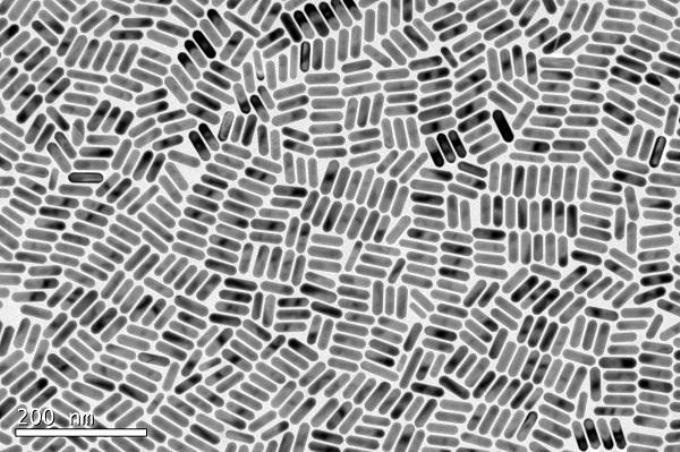Nov 6 2017
An innovative laser system that can be used to shape nanometric gold particles, measuring one-millionths of a millimeter, to enhance their characteristics in photonics and biomedicine has been developed through a research conducted at the Universidad Complutense de Madrid (UCM). The study has now been reported in the Science journal.
 These are ultramonodisperse gold nanorods that behave as clones from an optical point of view. CREDIT: Guillermo González Rubio.
These are ultramonodisperse gold nanorods that behave as clones from an optical point of view. CREDIT: Guillermo González Rubio.
The study—which also involved the CIC biomaGUNE and the Universidad Politécnica de Madrid (UPM)—symbolizes an outstanding achievement in optical quality wherein billions of gold nanoparticles act like a single particle, and also puts forth an innovative technique for transforming and enhancing nanomaterials by using lasers similar to chisels used by a sculptor.
By using ultrafast lasers, which are very intense but very short in duration (of the order of a billion trillion flashes per second), we have realized a world record in optical quality, where all the obtained shaped particles behave like nano-sized clones.
Andrés Guerrero Martínez, researcher at the Ramón y Cajal Program at the Faculty of Chemical Sciences of the UCM.
The research offers the chemical and physical hints needed to perceive and control these nanomaterials, which are regarded to be “perfect” from an optical perspective.
“We have tried during the last fifteen years to obtain identical nanoparticles, so that they all present the same color and their applications are more efficient. In this work, we have focused on the use of gold nanorods, in which minimal variations in their length or width result in significant changes in the color of the light they absorb,” stated Luis Liz Marzán, researcher at the Ikerbasque Program and scientific director of CIC biomaGUNE.
From tumor treatment to pollution remediation
The uses of nanoparticles are dependent on their potential to absorb and reflect a particular colors of light in an astonishingly effective manner. These plasmonic effects pave the way for optical characteristics unable to be accomplished by using metals of larger sizes, even at the millimeter level.
These characteristics can be exploited for various useful applications that, by and large, could not be achieved till date. In the case of medicine, apart from using the light reflected from the particles to diagnose diseases, the light absorption characteristics of the particle can also be used to actuate heat release for, for instance, treating tumors in a localized manner, thus reducing the normal side effects of prevalent treatments.
“Plasmonic particles have also found applications in areas such as information technology, energy production, or environmental pollution control, among others,” stated Guillermo González Rubio, co-author of the paper who received his PhD from the UCM under the guidance of Andrés Guerrero Martínez and Luis Liz Marzán.
One more innovative feature of this study is the use of ultrafast lasers to shape the geometry of the particles and to fine-tune their characteristics. Luis Bañares, co-author of the article and professor at the UCM, works at the Ultrafast Laser Center (CLUR) at the UCM.
Moreover, in order to have an in-depth knowledge of the physical and chemical nature of the shaping technique, standard characterization processes such as electron microscopy and spectroscopy, but also new theoretical models as well as advanced computer simulation methods, were used.
“the demonstration of this goal and the explanation of the processes that allow it to happen represent a paradigm shift that may open new avenues for the development of nanomaterials with improved properties and applications.”
Ovidio Rodríguez Peña, UPM researcher,